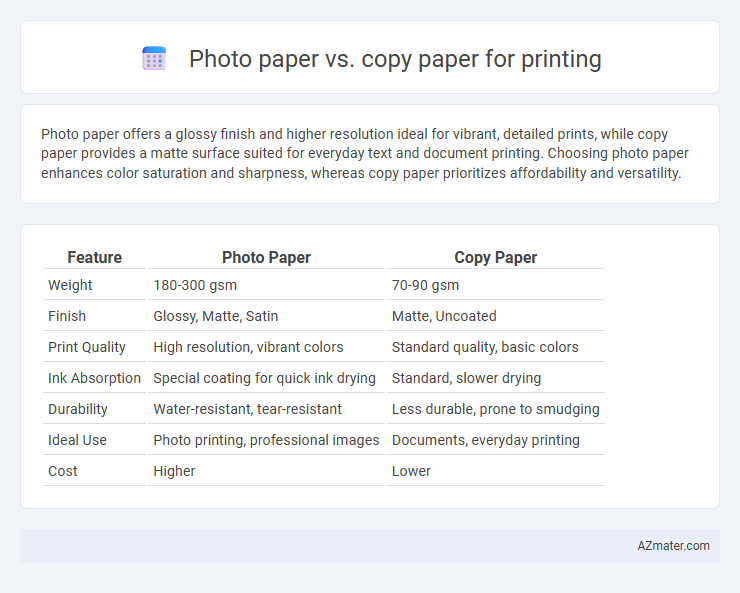Photo paper offers a glossy finish and higher resolution ideal for vibrant, detailed prints, while copy paper provides a matte surface suited for everyday text and document printing. Choosing photo paper enhances color saturation and sharpness, whereas copy paper prioritizes affordability and versatility.
Table of Comparison
| Feature | Photo Paper | Copy Paper |
|---|---|---|
| Weight | 180-300 gsm | 70-90 gsm |
| Finish | Glossy, Matte, Satin | Matte, Uncoated |
| Print Quality | High resolution, vibrant colors | Standard quality, basic colors |
| Ink Absorption | Special coating for quick ink drying | Standard, slower drying |
| Durability | Water-resistant, tear-resistant | Less durable, prone to smudging |
| Ideal Use | Photo printing, professional images | Documents, everyday printing |
| Cost | Higher | Lower |
Key Differences Between Photo Paper and Copy Paper
Photo paper features a glossy or matte coating designed to absorb ink precisely, producing vibrant colors and sharp details ideal for high-quality photo printing. Copy paper lacks this coating, resulting in lower ink absorption and duller prints, making it suitable primarily for text documents and everyday printing tasks. The thickness and brightness of photo paper are significantly higher than copy paper, enhancing image clarity and durability.
Composition and Coating: What Sets Them Apart
Photo paper features a high-quality composition with a dense, smooth surface designed to absorb ink evenly, enhancing color vibrancy and sharpness. Its specialized coating contains multiple layers, including a glossy or matte finish, that prevent ink spread and ensure rapid drying for crisp images. In contrast, copy paper is typically made from lower-grade wood pulp with no coating, resulting in a porous texture that absorbs ink unevenly and produces duller prints.
Print Quality: Image Clarity and Color Vibrancy
Photo paper significantly enhances print quality by providing superior image clarity and vibrant color reproduction due to its specially coated surface that absorbs ink evenly and prevents smudging. Copy paper, designed primarily for text documents, lacks the coating required for rich color saturation and sharp detail, resulting in duller images and less precise color gradients. For professional-quality prints, especially photographs or colorful graphics, photo paper is essential to achieve true-to-life colors and crisp visual detail.
Suitable Printing Applications for Each Paper Type
Photo paper is ideal for high-quality photo prints, marketing materials, and professional presentations due to its glossy or matte finish that enhances color vibrancy and detail. Copy paper is best suited for everyday printing tasks such as documents, drafts, and text-heavy reports, offering affordability and compatibility with most printers. Choosing the right paper improves print quality and durability based on the specific printing application.
Paper Weight and Thickness Comparison
Photo paper typically has a higher paper weight ranging from 180 to 300 gsm, offering greater thickness and durability compared to copy paper, which usually ranges between 70 and 90 gsm. The increased thickness of photo paper enhances image quality by preventing ink bleed-through and providing a smoother surface for vibrant color reproduction. In contrast, copy paper's lighter weight and thinner profile make it suitable for everyday printing tasks but less ideal for high-quality photographic outputs.
Cost-Effectiveness: Budgeting for Print Projects
Photo paper delivers superior print quality with vibrant colors and sharp details, making it ideal for professional photo prints but comes at a higher cost per sheet compared to copy paper. Copy paper is significantly more affordable and suitable for bulk printing tasks such as drafts and everyday documents, offering cost-effectiveness for large volumes but inferior image quality. Budgeting for print projects requires balancing print quality against quantity needs, where choosing copy paper reduces expenses while photo paper is reserved for premium outputs that justify the higher investment.
Ink Absorption and Drying Times
Photo paper features a specially coated surface that maximizes ink absorption, resulting in vivid color reproduction and sharp image quality, while significantly reducing drying times compared to copy paper. Copy paper, with its porous texture and lack of coating, absorbs ink less efficiently, often leading to slower drying times and potential smudging. Inkjet printers achieve optimal performance on photo paper due to the controlled ink absorption rate, enhancing print durability and color accuracy.
Printer Compatibility Considerations
Photo paper is specifically designed for inkjet printers with high-resolution capabilities, allowing for vibrant color reproduction and sharp image detail, making it ideal for printing photographs and high-quality images. Copy paper, on the other hand, is compatible with a wider range of printers including laser and inkjet models, but it lacks the coating necessary for optimal ink absorption, resulting in lower image quality. When selecting paper, ensure the printer supports the paper thickness and finish to prevent jams and achieve the best possible print results.
Environmental Impact and Recyclability
Photo paper typically contains plastic coatings and chemical treatments that hinder its recyclability and contribute to higher environmental impact due to increased resource use and waste generation. Copy paper, made from untreated wood fibers, is generally more eco-friendly, easily recyclable, and often produced from recycled materials, reducing its overall carbon footprint. Choosing copy paper over photo paper significantly decreases environmental strain by minimizing landfill waste and supporting circular fiber economies.
Choosing the Right Paper for Your Printing Needs
Choosing the right paper for your printing needs depends on the desired print quality and purpose; photo paper offers a glossy or matte finish with vibrant color reproduction ideal for high-resolution images and photographs, while copy paper is designed for everyday document printing with lower cost and standard ink absorption. Photo paper typically has a thicker weight and special coatings that prevent ink bleed and enhance image sharpness, making it essential for professional photo prints and marketing materials. Copy paper, being thinner and more porous, is better suited for text-heavy documents, drafts, and office printing where cost efficiency and speed are priorities.

Infographic: Photo paper vs Copy paper for Printing
 azmater.com
azmater.com